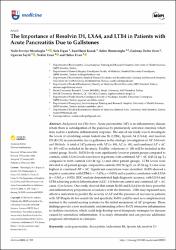| dc.contributor.author | Mısırlıoğlu, Naile Fevziye | |
| dc.contributor.author | Ergün, Sefa | |
| dc.contributor.author | Küçük, Suat Hayri | |
| dc.contributor.author | Himmetoğlu, Şölen | |
| dc.contributor.author | Özen, Gülenay Defne | |
| dc.contributor.author | Sayılı, Uğurcan | |
| dc.contributor.author | Uzun, Nedim | |
| dc.contributor.author | Uzun, Hafize | |
| dc.date.accessioned | 2025-03-22T15:08:53Z | |
| dc.date.available | 2025-03-22T15:08:53Z | |
| dc.date.issued | 2025 | en_US |
| dc.identifier.citation | Mısırlıoglu, N. F., Ergun, S., Kucuk, S. H., Himmetoglu, S., Ozen, G. D., Sayili, U., Uzun, N., & Uzun, H. (2025). The Importance of Resolvin D1, LXA4, and LTB4 in Patients with Acute Pancreatitis Due to Gallstones. Medicina, 61(2), 239. https://doi.org/10.3390/medicina61020239 | en_US |
| dc.identifier.issn | 1010-660X | |
| dc.identifier.uri | https://hdl.handle.net/20.500.12900/619 | |
| dc.description.abstract | Background and Objectives: Acute pancreatitis (AP) is an inflammatory disease where there is autodigestion of the pancreas by prematurely activated enzymes which may lead to a systemic inflammatory response. The aim of our study was to investigate the levels of circulating serum leukotriene B4 (LTB4), lipoxin A4 (LXA4), and resolvin D1 (RvD1) in pancreatitis due to gallstones in the etiologic investigation of AP. Materials and Methods: A total of 147 patients with AP (n: 49), AC (n: 49), and combined AP + AC (n: 49) will be included in the study. Healthy volunteers (n: 49) will be included as the control group. Results: RvD1 levels were significantly lower in patient groups compared to controls, while LXA4 levels were lower in patients with combined AP + AC (145.24 ng/L) compared to both controls (312.36 ng/L) and other patient groups. LTB4 levels were elevated in all patient groups compared to controls (335.56 ng/L vs. 65.56 ng/L) and were highest in combined AP + AC. Significant correlations were identified: RvD1 showed a negative correlation with LTB4 (r =-0.676; p < 0.001) and a positive correlation with LXA4 (r = 0.563, p < 0.001). ROC analysis demonstrated high diagnostic accuracy, with LXA4 and LTB4 achieving perfect differentiation (AUC: 1.0) between control and combined AP + AC cases. Conclusions: Our study showed that serum RvD1 and LXA4 levels have powerful anti-inflammatory properties in accordance with the literature. LTB4 may represent new, effective indicators to predict the severity of AP and the presence of necrosis in patients with AP. Despite its low sensitivity and specificity, RvD1 could be used as a complementary marker to the current scoring systems for the initial assessment of AP prognosis. These findings provide a new mechanistic understanding of how RvD1 attenuates inflammation to facilitate resolution, which could help develop novel therapeutic strategies for diseases caused by unresolved inflammation. It is easily obtainable and can provide additional prognostic information to clinicians. | en_US |
| dc.language.iso | eng | en_US |
| dc.publisher | MDPI | en_US |
| dc.relation.isversionof | 10.3390/medicina61020239 | en_US |
| dc.rights | info:eu-repo/semantics/openAccess | en_US |
| dc.subject | Acute pancreatitis | en_US |
| dc.subject | Cholecystitis | en_US |
| dc.subject | Leukotriene B4 | en_US |
| dc.subject | Lipoxin A4 | en_US |
| dc.subject | Resolvin D1 | en_US |
| dc.title | The Importance of Resolvin D1, LXA4, and LTB4 in Patients with Acute Pancreatitis Due to Gallstones | en_US |
| dc.type | article | en_US |
| dc.department | İstanbul Atlas Üniversitesi, Tıp Fakültesi, Temel Tıp Bilimleri Bölümü | en_US |
| dc.contributor.institutionauthor | Uzun, Hafize | |
| dc.identifier.volume | 61 | en_US |
| dc.identifier.issue | 2 | en_US |
| dc.relation.journal | MEDICINA-LITHUANIA | en_US |
| dc.relation.publicationcategory | Makale - Uluslararası Hakemli Dergi - Kurum Öğretim Elemanı | en_US |

















